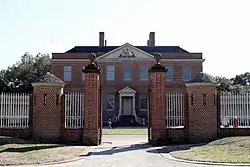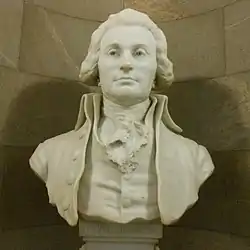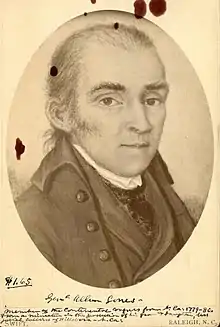North Carolina Provincial Congress
The North Carolina Provincial Congresses were extra-legal unicameral legislative bodies formed in 1774 through 1776 by the people of the Province of North Carolina, independent of the British colonial government. There were five congresses. They met in the towns of New Bern (1st and 2nd), Halifax (4th and 5th), and Hillsborough (3rd). The 4th conference approved the Halifax Resolves a set of resolutions that empowered the state's delegates to the Second Continental Congress to concur in the Declaration of Independence from Great Britain. The 5th conference approved the Constitution of North Carolina and elected Richard Caswell as governor of the State of North Carolina. After the 5th conference, the new North Carolina General Assembly met in April 1777.
_(1774)_(14775897882).jpg.webp)
Congresses
Five extra-legal unicameral bodies called the North Carolina Provincial Congresses met beginning in the summer of 1774. They were modeled after the colonial lower house (House of Commons). These congresses created a government structure, issued bills of credit to pay for the movement, organized an army for defense, wrote a constitution and bill of rights that established the state of North Carolina, and elected their first acting governor in the fifth congress that met in 1776. These congresses paved the way for the first meeting of the North Carolina state Legislature on April 7, 1777 in New Bern, North Carolina.[1]
First Provincial Congress

The first such congress met at the Tryon Palace in New Bern, from August 25 to 27, 1774. It was the first such gathering anywhere in the Thirteen Colonies held in defiance of British orders.[2][3][4]
Its moderator (president) was John Harvey, who was concurrently the last speaker of the Province of North Carolina General Assembly of 1775 House of Burgesses.[4]
This first provincial congress, with 69 delegates from 30 of the then-36 counties, approved the calling of a Continental Congress and elected William Hooper, Joseph Hewes, and Richard Caswell as the colony's delegates thereto. The congress also approved a trade boycott to protest British actions against New England.[3][4]
Second Provincial Congress
The second congress also met at New Bern, from April 3 to 7, 1775. John Harvey once again served as moderator. The congress met at the same place and almost the same time as the colonial assembly, and had almost exactly the same membership. This infuriated the royal governor Josiah Martin, who dissolved the colonial legislature on April 8 and never called another. This congress approved the Continental Association, an economic boycott authorized by the Continental Congress. Just after this congress met, news reached North Carolina about the Battle of Lexington and Concord in Massachusetts. Following this news, Governor Josiah Martin fled and this ended the royal government in the Province. The first military action occurred on July 18 when patriots burned Fort Johnston, where Governor Martin had transferred his headquarters.[5][4]
Third Provincial Congress

The third congress met in Hillsborough, from August 20 to September 10, 1775. Its president was Samuel Johnston (Harvey had recently died). This congress, which included representatives of every county and town, officially established itself as the highest governmental body in the province (British Governor Martin had fled, ending royal government).[6][4]
To govern North Carolina when the congress was not in session, a 13-member Provincial Council, or Council of Safety, was elected, constituting the first executive body in a North Carolina free of British rule. Cornelius Harnett was elected as the first president of the council. The congress divided the state into 6 military districts for purposes of organizing militia and for determining representation on the Council. These districts included Edenton, Halifax, Hillsborough, New Bern, Salisbury, and Wilmington. Later, an additional district, Morgan, was added for the western part of the state, including counties that eventually became part of Tennessee (Davidson, Greene, and Washington).[7][4]
Fourth Provincial Congress

In the present day, the fourth North Carolina Provincial Congress is sometimes referred to as the "Halifax Assembly." The fourth congress, also presided over by Samuel Johnston, met in Halifax, from April 4 to May 14, 1776. Allen Jones served as vice-president.[2][8][4]
This congress passed what became known as the Halifax Resolves, the first "official" endorsement of independence from Great Britain by one of the Thirteen Colonies. Joseph Hewes presented the Halifax Resolves to the Continental Congress on May 27, the same day that Virginia delegates presented similar resolves.[2][4]
Fifth Provincial Congress

The Fifth and last Provincial Congress met at Halifax from November 12 to December 23, 1776. Richard Caswell served as president, with Cornelius Harnett as vice-president.[2][9][4]
This congress approved the first Constitution of North Carolina, along with a "Declaration of Rights." It elected Caswell to serve as acting governor until the province's first General Assembly could meet to elect a governor.[2][4]
See also
References
- Butler, Lindley (2006). Powell, William Stevens (ed.). Encyclopedia of North Carolina, Provincial Congresses. University of North Carolina Press. pp. 917–918. ISBN 0807830712.
- "State Library of North Carolina. Information page for Tryon Palace". Archived from the original on 2008-05-03.
- Lewis, J.D. "1st Provincial Congress". The American Revolution in North Carolina. Retrieved August 13, 2019.
- Connor, Robert Diggs Wimberly, ed. (1913). A Manual of North Carolina Issued by the North Carolina Historical Commission for the Use of Members of the General Assembly Session 1913. Retrieved August 13, 2019.
- Lewis, J.D. "Members of the 2nd Provincial Congress". The American Revolution in North Carolina. Retrieved August 13, 2019.
- Lewis, J.D. "3rd Provincial Congress". The American Revolution in North Carolina. Retrieved August 13, 2019.
- Lewis, J.D. "North Carolina Militia". "The American Revolution in North Carolina. Retrieved August 13, 2019.
- Lewis, J.D. "4th Provincial Congress". The American Revolution in North Carolina. Retrieved August 13, 2019.
- Lewis, J.D. "5th Provincial Congress". The American Revolution in North Carolina. Retrieved August 13, 2019.
Further reading
- Lamm, Alan (2006). Powell, William Stevens (ed.). Encyclopedia of North Carolina, First North Carolina Conflicts and the Establishment of a Provincial Government. University of North Carolina Press. pp. 40–41. ISBN 0807830712.
- Kughler, Frances Vandeveer. "Murals at the UNC School of Government, including a depiction of the 4th Provincial Congress". UNC School of Government. Retrieved August 13, 2019.
- Powell, William S. (1988). North Carolina: A History. University of North Carolina Press. p. 248. ISBN 0807842192.